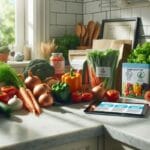Going Gluten-Free With Diabetes: What You Need to Know
Published: June 2024 | Updated for 2025 SEO Best Practices
Living with diabetes already requires careful attention to your diet, but what happens when you also need to go gluten-free? Whether due to celiac disease, gluten sensitivity, or personal dietary preferences, managing both diabetes and a gluten-free lifestyle can seem overwhelming. However, with the right knowledge, tools, and support, you can thrive while meeting both dietary needs.
In this comprehensive guide, we’ll explore the essentials of going gluten-free with diabetes, referencing the latest research and expert advice, including insights from Everyday Health’s recent article. We’ll also discuss how innovative tools like Food Scan Genius can make your gluten-free diabetic journey easier and safer.
Why Go Gluten-Free With Diabetes?
Gluten is a protein found in wheat, barley, and rye. For most people, gluten is harmless. However, for those with celiac disease, consuming gluten triggers an immune response that damages the small intestine. Non-celiac gluten sensitivity can also cause uncomfortable symptoms. According to the CDC, people with type 1 diabetes are at higher risk for celiac disease, with prevalence rates up to 10 times higher than the general population.
If you have diabetes and are diagnosed with celiac disease or gluten sensitivity, a gluten-free diet is medically necessary. Others may choose to avoid gluten for personal or health reasons. However, eliminating gluten can impact your blood sugar management, nutrient intake, and food choices.
Understanding the Challenges: Gluten-Free and Diabetic Diets
Both diabetes and gluten-free diets come with unique challenges. Combining the two requires extra vigilance:
- Carbohydrate Counting: Many gluten-free products are made with refined starches (rice, corn, potato) that can spike blood sugar quickly.
- Nutrient Deficiencies: Gluten-free diets may lack fiber, B vitamins, iron, and other essential nutrients, which are already a concern for some people with diabetes.
- Cross-Contamination: Even small amounts of gluten can trigger symptoms in sensitive individuals, making label reading and food preparation critical.
- Limited Food Choices: Dining out and shopping can be more challenging, especially when managing both conditions.
Recent Research: Gluten-Free Diets and Diabetes (2023-2024)
Recent studies have shed light on the intersection of gluten-free diets and diabetes management:
- Blood Sugar Control: A 2023 review in Diabetes Therapy found that gluten-free diets can improve glycemic control in people with type 1 diabetes and celiac disease, but only when the diet is balanced and nutrient-dense.
- Gut Health: Research published in Frontiers in Nutrition (2024) suggests that gluten-free diets may alter gut microbiota, which can influence insulin sensitivity and inflammation.
- Quality of Life: A 2024 survey in Journal of Diabetes Research reported that individuals with both diabetes and celiac disease experienced improved quality of life after adopting a gluten-free diet, especially when supported by dietitians and digital tools.
These findings highlight the importance of a well-planned gluten-free diabetic diet, emphasizing whole foods, fiber, and balanced macronutrients.
Safe Gluten-Free Foods for People With Diabetes
The foundation of a healthy gluten-free, diabetic-friendly diet is naturally gluten-free whole foods that are low on the glycemic index (GI) and rich in nutrients. Here are some top choices:
- Vegetables: Leafy greens, broccoli, cauliflower, peppers, carrots, zucchini, and more.
- Fruits: Berries, apples, pears, citrus fruits (in moderation for carb counting).
- Proteins: Eggs, poultry, fish, lean meats, tofu, legumes (check for added gluten in processed meats).
- Gluten-Free Whole Grains: Quinoa, buckwheat, millet, amaranth, certified gluten-free oats, brown rice.
- Healthy Fats: Avocado, nuts, seeds, olive oil, coconut oil.
Always check for gluten-containing additives or cross-contamination, especially in packaged foods.
Foods to Avoid: Hidden Sources of Gluten
Gluten is found in many obvious and hidden sources. For those with celiac disease or severe gluten sensitivity, even trace amounts can be harmful. Common sources of gluten include:
- Bread, pasta, cereals, baked goods made with wheat, barley, or rye
- Soups, sauces, and gravies thickened with wheat flour
- Processed meats, imitation seafood, and flavored snacks
- Beer, malt beverages, and some flavored alcoholic drinks
- Some medications and supplements (check labels)
Always read ingredient lists and look for certified gluten-free labels. When in doubt, use a trusted food scanning app or consult your healthcare provider.
Managing Cross-Contamination: Essential for Gluten-Free Safety
Cross-contamination occurs when gluten-free foods come into contact with gluten-containing foods, surfaces, or utensils. This is a major concern for people with celiac disease or high gluten sensitivity.
- Use separate toasters, cutting boards, and utensils for gluten-free foods.
- Clean kitchen surfaces thoroughly before preparing gluten-free meals.
- Store gluten-free products separately from gluten-containing items.
- Be cautious when dining out; ask about preparation methods and dedicated gluten-free areas.
According to Everyday Health, cross-contamination is one of the leading causes of accidental gluten exposure, making vigilance and technology essential.
Reading Labels and Dining Out: Staying Gluten-Free and Diabetic-Friendly
Label reading is a vital skill for anyone managing food sensitivities or dietary preferences. Here’s what to look for:
- Certified gluten-free seals from reputable organizations
- Ingredient lists for hidden sources of gluten and added sugars
- Nutrition facts to monitor carbohydrates, fiber, and sugar content
When dining out:
- Call ahead to ask about gluten-free and diabetic-friendly options
- Inform your server about both your gluten-free and diabetic needs
- Ask about preparation methods and cross-contamination risks
How Food Scan Genius Makes Gluten-Free Living With Diabetes Easier
Technology is transforming how we manage food sensitivities and dietary restrictions. Food Scan Genius is a cutting-edge app designed for people with multiple dietary needs, including gluten-free and diabetic-friendly diets.
- Instant Label Scanning: Use your smartphone to scan barcodes and instantly check if a product is gluten-free and suitable for diabetes management.
- Personalized Filters: Set your dietary preferences (gluten-free, low-carb, low-sugar, etc.) for customized recommendations.
- Cross-Contamination Alerts: Get warnings about potential cross-contamination risks in packaged foods and restaurant menus.
- Nutrient Tracking: Monitor your daily intake of carbs, fiber, sugar, and more, helping you balance your blood sugar while avoiding gluten.
- Community Support: Connect with others managing similar dietary needs, share tips, and discover new products.
Food Scan Genius empowers you to make safer, smarter choices at home, in stores, and on the go. For people with diabetes and gluten sensitivity, it’s a game-changer for reducing stress and avoiding accidental exposures.
Tips for a Balanced Gluten-Free, Diabetic-Friendly Diet
- Focus on whole, unprocessed foods for better blood sugar control and nutrient intake.
- Choose gluten-free whole grains with a low glycemic index, such as quinoa and buckwheat.
- Include fiber-rich vegetables and healthy fats to slow carbohydrate absorption.
- Plan meals and snacks ahead to avoid last-minute, high-carb, or processed gluten-free foods.
- Work with a registered dietitian experienced in both diabetes and gluten-free diets.
- Use technology like Food Scan Genius to simplify shopping and meal planning.
Frequently Asked Questions (FAQs)
- Can a gluten-free diet help prevent diabetes?
- There’s no strong evidence that a gluten-free diet prevents diabetes in the general population. However, for those with celiac disease and type 1 diabetes, a gluten-free diet is essential for gut health and overall well-being.
- Are gluten-free foods always healthier for people with diabetes?
- No. Many processed gluten-free foods are high in refined starches and sugars, which can spike blood sugar. Focus on naturally gluten-free, whole foods for better health.
- How can I avoid cross-contamination at home?
- Use separate kitchen tools, clean surfaces thoroughly, and store gluten-free foods apart from gluten-containing items. Consider labeling utensils and appliances.
- Is it safe to eat out on a gluten-free, diabetic diet?
- Yes, but it requires planning. Research restaurants, communicate your needs, and use apps like Food Scan Genius to check menu items for both gluten and carb content.
Conclusion: Thriving Gluten-Free With Diabetes
Going gluten-free with diabetes is a journey that requires education, planning, and support. By focusing on whole foods, reading labels, managing cross-contamination, and leveraging technology like Food Scan Genius, you can enjoy a varied, satisfying diet that supports your health goals.
For more details, expert interviews, and personal stories, see the full Spread the love





